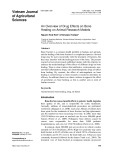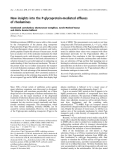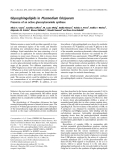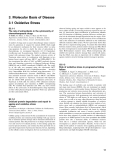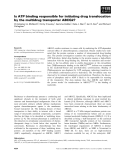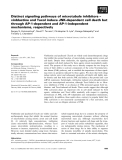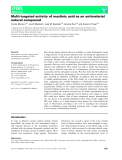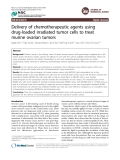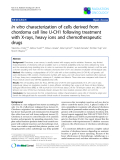


Chemotherapeutic drugs
-
The present research reviewed previously published studies with the objective to enhance the understandings of the effects of different drugs on bone healing. There is clear evidence that antibiotics, corticosteroids, nonsteroidal inflammatory drugs, and chemotherapeutic drugs all affect bone healing.
 11p
11p  chauchaungayxua12
chauchaungayxua12
 09-07-2021
09-07-2021
 14
14
 2
2
 Download
Download
-
Multidrug resistance (MDR) in tumour cells is often caused by the overexpression of the plasma drug transporter P-glycoprotein (P-gp). This protein is an active efflux pump for chemotherapeutic drugs,natural products and hydro-phobicpeptides.Despite theadvancesof recent years,we still have an unclear view of the molecular mechanismby which P-gp transports such a wide diversity of compounds across themembrane.
 10p
10p  tumor12
tumor12
 20-04-2013
20-04-2013
 46
46
 4
4
 Download
Download
-
Malaria remains a major health problem especially in trop-ical and subtropical regions of the world, and therefore developing new antimalarial drugs constitutes an urgent challenge. Lipid metabolism has been attracting a lot of attention as an application for malarial chemotherapeutic purposes in recent years. However, little is known about glycosphingolipid biosynthesis inPlasmodium falciparum. In this report we describe for the first time the presence of an active glucosylceramide synthase in the intraerythrocytic stages of the parasite....
 11p
11p  dell39
dell39
 03-04-2013
03-04-2013
 34
34
 4
4
 Download
Download
-
A number of drugs used in cancer chemotherapy induce oxidative stress by generation of oxygen free radicals (ROS) which might be an alternative mechanism for their cytotoxic effect via indu-cing apoptosis. In order to clarify the roles of antioxidants in chemotherapy, we investigated Quercetin (3,3’,4’,5,7-pentahyd-roxyflavone) and N-acetylcysteine (NAC) in different cell types treated with anticancer drugs. We studied cytotoxic activity of Topotecan alone and/or in combination with Quercetin in two human breast cancer cell lines, MCF-7 and MDA-MB-231. ...
 7p
7p  inspiron33
inspiron33
 26-03-2013
26-03-2013
 57
57
 4
4
 Download
Download
-
ABCG2 confers resistance to cancer cells by mediating the ATP-dependent outward efflux of chemotherapeutic compounds. Recent studies have indi-cated that the protein contains a number of interconnected drug binding sites. The present investigation examines the coupling of drug binding to ATP hydrolysis.
 9p
9p  galaxyss3
galaxyss3
 07-03-2013
07-03-2013
 46
46
 4
4
 Download
Download
-
Vinblastine and paclitaxel (Taxol) are widely used chemotherapeutic drugs that inhibit the normal function of microtubules causing mitotic arrest and cell death. Despite these similarities, the signaling pathways that mediate and regulate cell death induced by these agents remain incompletely under-stood.
 11p
11p  media19
media19
 06-03-2013
06-03-2013
 52
52
 2
2
 Download
Download
-
Most drugs against malaria that are available or under development target a single process of the parasite infective cycle, favouring the appearance of resistant mutants which are easily spread in areas under chemotherapeutic treatments.
 11p
11p  cosis54
cosis54
 04-01-2013
04-01-2013
 33
33
 4
4
 Download
Download
-
Ovarian cancer is the leading cause of death among women with gynecologic malignancies in the United States. Advanced ovarian cancers are difficult to cure with the current available chemotherapy, which has many associated systemic side effects. Doxorubicin is one such chemotherapeutic agent that can cause cardiotoxicity. Novel methods of delivering chemotherapy without significant side effects are therefore of critical need.
 12p
12p  toshiba23
toshiba23
 18-11-2011
18-11-2011
 57
57
 4
4
 Download
Download
-
Tuyển tập các báo cáo nghiên cứu về y học được đăng trên tạp chí y học Radiation Oncology cung cấp cho các bạn kiến thức về ngành y đề tài: In vitro characterization of cells derived from chordoma cell line U-CH1 following treatment with X-rays, heavy ions and chemotherapeutic drugs...
 9p
9p  toshiba10
toshiba10
 15-10-2011
15-10-2011
 59
59
 3
3
 Download
Download
CHỦ ĐỀ BẠN MUỐN TÌM







